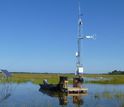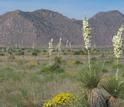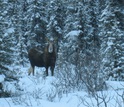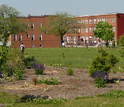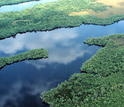Media Advisory 15-001
Primary productivity--"nature's alchemy"--focus of annual NSF Long-Term Ecological Research mini-symposium
Process at base of food web affects health of one ecosystem to entire globe
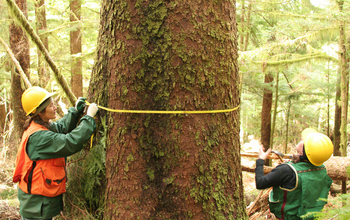
In a forest productivity study, NSF H.J. Andrews LTER site scientists measure a Sitka spruce.
January 22, 2015
This material is available primarily for archival purposes. Telephone numbers or other contact information may be out of date; please see current contact information at media contacts.
A webcast of the 2015 NSF LTER Mini-Symposium is available for viewing and download.
Nature's alchemy, it might be called. At the base of Earth's food webs, organisms convert sunlight, water and carbon dioxide into chemical energy.
Primary productivity, as the process is known, is everywhere: in growing forests, lawns that need mowing, and spreading algae blooms.
But its manifestations differ from place-to-place and year-to-year, scientists say, even if we compare forests to forests or streams to streams. This variability has led researchers to ask why.
Answering the question is far from simple, they say.
Understanding where, when, how and why primary production changes has been a central question for ecologists. It's a core research topic for sites in the National Science Foundation (NSF) Long-Term Ecological Research (LTER) Network. NSF LTER sites are located in ecosystems from deserts to grasslands, coral reefs to Arctic tundra.
NSF mini-symposium to address patterns, controls of primary productivity
The 2015 annual NSF LTER mini-symposium, to be held on Thursday, March 5th, will focus on the patterns and controls of primary production across these ecosystems.
Researchers will discuss how and why primary production varies over space and time, focusing on two key features of the LTER program: long-term perspectives and cross-site comparisons.
"Natural populations and communities change constantly, but does the energy they require change with similar magnitude and frequency?" asks Saran Twombly, LTER program director in NSF's Division of Environmental Biology.
"Scientists will present the results of analyses of long-term data on primary production," says Twombly. "These data, from many LTER projects, document how primary production changes as a result of climate, location and the species present."
Long-term studies lead to predictions of ecosystem-wide effects
"Primary production is a measure of 'ecosystem services' common to all LTER sites," says David Garrison, NSF LTER program director in NSF's Division of Ocean Sciences. "Change related to climate and the environment is a timely and important topic."
For example, long-term studies lead to better predictions of the effects of drought on grasslands at the Jornada LTER site in New Mexico and at other LTER grassland sites.
At the H.J. Andrews Forest LTER site in Oregon, more than 50 years of research are revealing patterns of tree growth--patterns that challenge conventional ecological models of forest productivity.
Cross-site comparisons are an important way of describing and understanding variability in primary production among similar ecosystems, says Twombly.
The approach may be used to unravel the mystery of why light and temperature can have strong effects on primary production in one stream or lake, but little or no effect in another.
Comparisons of coastal marshes at the Plum Island Ecosystems, Virginia Coastal Reserve and Georgia Coastal Ecosystems LTER sites are helping scientists learn whether plant growth in coastal marshes will be able to keep pace with sea level rise--or be swamped by ever-higher waters.
Animals also play a major role in affecting the rate of primary production on land and in the sea. Long-term studies at the Arctic and Bonanza Creek LTER sites offer examples of how boom-and-bust cycles of predators and prey can have cascading effects on plants and overall rates of primary production.
Human activities have longest reach
It's human activities, however, that now have the largest effect on primary production--from one ecosystem to the entire globe.
Long-term research at agricultural and urban LTER sites shows that our footprints are both increasing and decreasing rates of primary production by redistributing the basic ingredients of water and nutrients needed.
|
Who: |
NSF LTER Network Scientists |
|
What: |
NSF LTER Annual Mini-Symposium |
|
When: |
Thursday, March 5, 2015, 8:30 a.m. - 12:00 p.m. |
|
Where: |
National Science Foundation, Room 110 |
Detailed agenda: NSF LTER primary productivity mini-symposium
|
8:30 a.m. |
Welcome and Opening Comments |
|
8:45 a.m. |
Grasslands and multi-year drought: Using long-term data to inform past mysteries and minimize future surprises |
|
9:15 a.m. |
Timing is everything: Understanding short- and long-term variability in light and temperature on inter-biome freshwater ecosystem production |
|
9:45 a.m. |
Forest net primary production: Examining spatial and temporal heterogeneity within the LTER Network |
|
10:15 a.m. |
Break |
|
10:30 a.m. |
Marsh equilibrium theory: feedbacks and tipping points |
|
11:00 a.m. |
The changing nature of trophic cascades at high latitudes |
|
11:30 a.m. |
Primary production in human-dominated ecosystems: Responses to human activities and provisioning of ecosystem services |
-NSF-
-
NSF's Plum Island Ecosystems LTER site with a research tower to measure salt marsh carbon dioxide.
Credit and Larger Version -
Jornada LTER site ecologists study the effects of multi-year droughts on grasslands.
Credit and Larger Version -
Bonanza Creek LTER site research shows that moose have pronounced effects on vegetation growth.
Credit and Larger Version -
Baltimore Ecosystem Study LTER site scientists and students are replacing asphalt with grass.
Credit and Larger Version -
View of the Florida Coastal Everglades LTER site; research focuses on the ecosystem's hydrology.
Credit and Larger Version
Media Contacts
Cheryl Dybas, NSF, (703) 292-7734, email: cdybas@nsf.gov
McOwiti Thomas, NSF LTER Network Office, (505) 277-2638, email: tmcowiti@lternet.edu
Related Websites
NSF LTER Network: www.lternet.edu
NSF LTER Discovery Article Series: http://nsf.gov/discoveries/disc_summ.jsp?cntn_id=132583
The U.S. National Science Foundation propels the nation forward by advancing fundamental research in all fields of science and engineering. NSF supports research and people by providing facilities, instruments and funding to support their ingenuity and sustain the U.S. as a global leader in research and innovation. With a fiscal year 2023 budget of $9.5 billion, NSF funds reach all 50 states through grants to nearly 2,000 colleges, universities and institutions. Each year, NSF receives more than 40,000 competitive proposals and makes about 11,000 new awards. Those awards include support for cooperative research with industry, Arctic and Antarctic research and operations, and U.S. participation in international scientific efforts.
Connect with us online
NSF website: nsf.gov
NSF News: nsf.gov/news
For News Media: nsf.gov/news/newsroom
Statistics: nsf.gov/statistics/
Awards database: nsf.gov/awardsearch/
Follow us on social
Twitter: twitter.com/NSF
Facebook: facebook.com/US.NSF
Instagram: instagram.com/nsfgov

